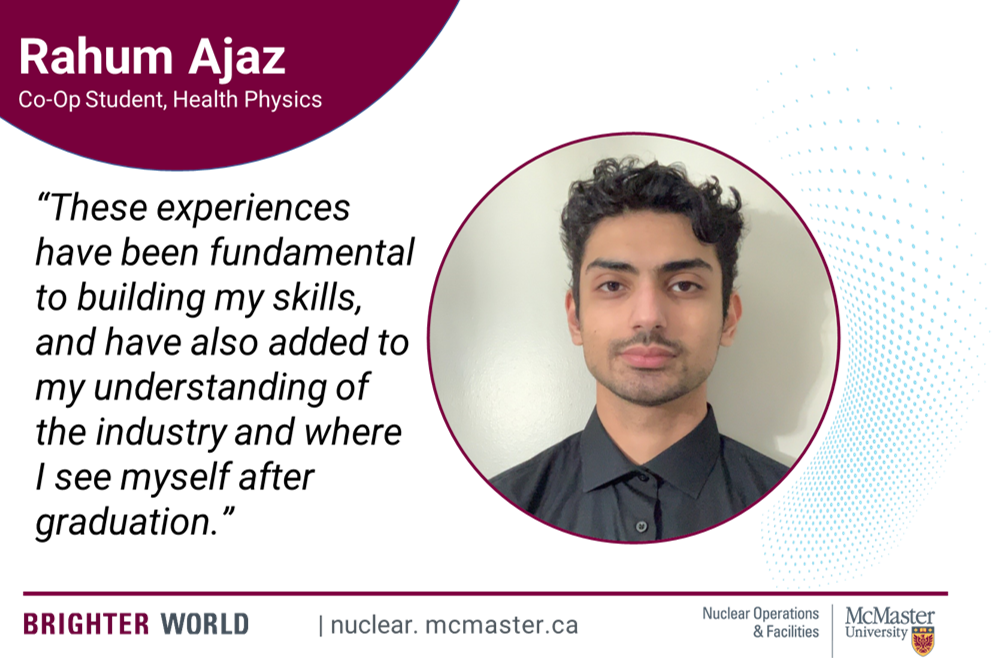A Work Term to Remember: In Conversation with Rahum Ajaz

McMaster University provides hands-on learning experiences to the next generation of nuclear scientists and engineers through co-op work placements and summer jobs. Recently, Rahum Ajaz sat down with NO&F scientist Matt Moran to talk about his co-op work-term experiences at McMaster.
Can you tell me about yourself, and how you came to work at McMaster?
I am going into my last year of Nuclear Engineering at Ontario Tech University. It’s a unique program not offered by many other university or colleges in Canada. It’s a four-year program, but with my co-op term it will take me five years to complete. This summer, I was hired for a Co-op work term as a Student Radiation Surveyor with the Health Physics Department at McMaster University.
“…it is very important to find ways to set yourself apart from everyone else. Grabbing opportunities is what matters the most.”
Tell me about your role at McMaster – what have you enjoyed most about your job?
Absolutely the variety of duties and the opportunities I’ve been given while working in this role. With so many more students choosing university or college after high school, it is very important to find ways to set yourself apart from everyone else. Grabbing opportunities is what matters the most. I started out performing thyroid scans to monitor nuclear energy workers for radioiodine uptake. But I’ve also participated in radiation surveys, waste management, and escorting personnel [into restricted access areas], as well as being able to attend seminars and meetings.I was also able to participate in an international collaboration as a North American Technical Centre (NATC) Nuclear Analyst. These experiences have been fundamental to building my skills, and has also added to my understanding of the industry and where I see myself after graduation.
“These experiences have been fundamental to building my skills, and have also added to my understanding of the industry and where I see myself after graduation”
Tell me more about this international collaboration.
Sure. When I started my Co-op term, Josip Zic [McMaster University’s Senior Health Physicist] forwarded a job opportunity with the North American Tech Centres, one of four Tech Centers for the OECD NEA/IAEA Information System on Occupational Exposure (ISOE), to work as a Nuclear Analyst. Essentially, I have been doing data collection and analysis for all the active and non-active nuclear reactors in Canada. Working with Josip Zic and Dr. David Miller at the University of Illinois, the goal has been to collect data on dose rates generated by each of the reactors, and to add that data to an international database of values for all nuclear reactors world-wide.
That sounds really interesting!
Right? This project will provide a lot of information: trends over time and across different facilities, as well as providing overall transparency. The hope is that reactors will be able to use this information to help improve processes and thus improve overall safety. It is a key goal of all nuclear work in the world to be constantly improving and making things safer.
“…reactors will be able to use this information to help improve processes and thus improve overall safety.”
It sounds like you’ve benefitted a lot from your participation in this project.
One hundred percent. First, I had to obtain the data, which involved a lot of liaison work with the 22 reactors across Canada. So, I’ve made a lot of contacts in the industry. Then there was the task of compiling the data and writing up the documentation, which taught me a lot about building a database and how to organize results so that they are accessible to everyone. Finally, I was able to observe how real-world situations impact the data, which helps immensely with interpretation. The data stops looking like “The Matrix” and begins to tell a story about potential conditions on the ground.
“The data stops looking like “The Matrix” and begins to tell a story about potential conditions on the ground.”
How do you view this opportunity in the broader context of your education?
I see it as analogous to building a house. The coursework and assignments are akin to building the foundation. Without that part, the structure won’t hold up. But being able to work in the Health Physics Department, as well as having access to all of these opportunities and seeing the overall operation of a research reactor, has really defined the framework and the interior of the house. It has definitely shaped the kind of nuclear employee that I want to be when I enter the workforce, and the skills that I will be able to bring to the table.
What do you ultimately hope to do once you graduate?
My first year I started the Life Sciences program at McMaster, but realized I needed to get into a program that was more focused on the job at the end of the program. So, I thought I would just become a Reactor Operator when I finished. Now that I’ve had this opportunity with Health Physics, I see limitless possibilities in the nuclear sector that would be a good fit with my skillset. Without this exposure, I may have ended up missing out on a potential dream job in the industry.
Blog“Now that I’ve had this opportunity… I see so many more possibilities that would be a good fit with my skillset. Without this exposure, I may have ended up missing out on a potential dream job in the industry.”
